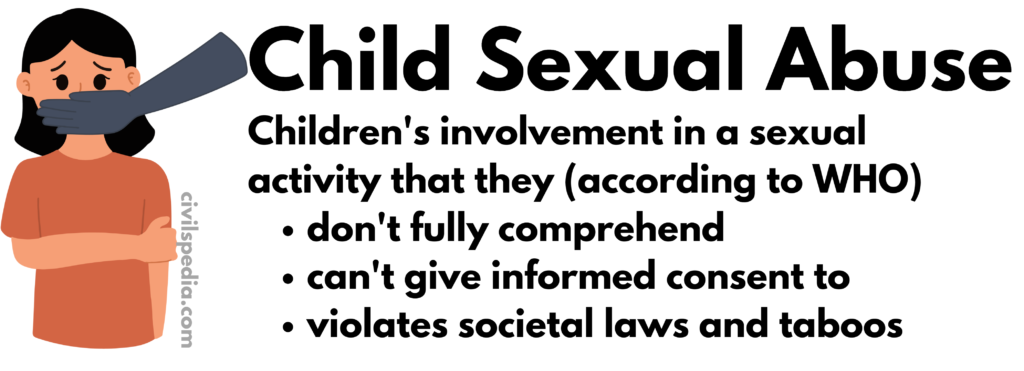Last Updated: May 2023 (Child Sexual Abuse in India)
Child Sexual Abuse in India
This article deals with ‘Child Sexual Abuse in India ’. This is part of our series on ‘Society’ which is an important pillar of the GS-1 syllabus. For more articles, you can click here.
Child Sexual Abuse

- 1.07 Lakh cases of Child Sexual Abuse in 2016 (NCRB data)
- (In)famous Example: the Bombay Orphanage Case ( 2011), where there was sexual abuse of young boys.
Causes of Child Sexual Abuse

- Poverty: In slums, children are most vulnerable to sexual abuse.
- Unregulated web content: Porn is freely available.
- Psychological reason: The person involved in these types of crimes has a history of sexual violence & generally, the culprit is once a victim of the same crime
- Cultural Norms and Taboos: cultural norms and taboos in India reinforce gender inequality, resulting in the stigmatization of survivors. Hence, these incidents are not reported.
- Lack of Sex Education: Sex Education is considered taboo in India. Hence, there is a lack of awareness about consent in healthy sexual relationships.
- The emergence of nuclear and dual-carrier families
- Weak Justice System: In India, laws such as POCSO Act exist. But due to a weak justice system, there is inadequate enforcement of laws.
- Lack of sanitization facilities within the home
Measure to Control Child Sexual Abuse in India
1. Constitutional Measures
- Article 23: Prohibition of traffic in human beings, begar & other similar forms of forced labour.
2. Legal Measures
2.1 POCSO (Prevention of Children against Sexual Offence) Act, 2012
- POCSO defines a child as a person below 18 years.
- Section 7 defines sexual assault of a child as “whoever, with sexual intent, touches the vagina, penis, anus, or breast of such person.”
- POCSO is gender-neutral law (the safety of both boys and girls is covered).
- It has widened the ambit of sexual abuse. It includes touch as well as non-touch behaviour.
- The act is non-bailable, cognizable and non-compoundable.
- For Penetrative Sexual Assault, the burden of proof is shifted on the accused.
- It has the provision of special courts, special public prosecutors and in-camera trials.
- The media is barred from disclosing the identity of the child.
2.2. Criminal Law (Amendment) Act, 2018
Section 376 of IPC has been amended with the following provisions.
- The minimum punishment for the offence of rape has been increased 10 years (from 7 years).
- The rape of a woman below 16 years has been made punishable for life.
- The rape of women below 12 years has been made punishable with imprisonment for life or death.
- The time limit of the investigation has been reduced to two months and six months for the disposal of cases.
2.3 CrPC (Amendment) Act, 2013
- The age of consent for sex increased from 16 to 18.
2.4 IT Act, 2000
- IT Act deals with the issue of pornography affecting children. Section 67 B states that browsing, publishing or transmitting any content which involves children in sexual activity is a criminal offence (5 years in jail).
3. Conventions
3.1 United Nations Convention on Rights of Child (UNCRC)
- It prohibits the use of children for sexual purposes.
4. NGOs
Various NGOs work in this regard
- Child Rights and You
- Bachpan Bachao Andolan
5. Schemes
- Aarambh Initiative: To curb sexual abuse of children through the internet and remove child pornographic content.
- Beti Bachao Beti Padhao
- Operation Muskaan: It aims to rehabilitate the missing children.
